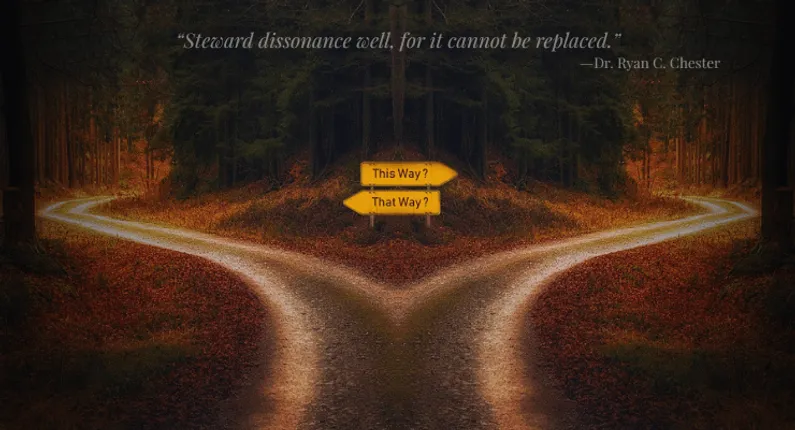
Stewarding the Non-replaceable Reality of Cognitive Dissonance
We have all had moments when our thoughts and behaviors stand in opposite corners of the proverbial ring. For example, we can verbally acknowledge that being too engaged in social media or death scrolling through more YouTube shorts is detrimental to our health, and yet not blink an eye as we continue to swipe through more videos or scroll through more posts. We can also declare that we will start exercising first thing on Monday morning while at the same time binge watch seasons 1–3 of our favorite TV show on Saturday and Sunday. Finally, we can voice the fact that people are not particularly accountable for their actions today while simultaneously misdirecting responsibility away from ourselves and onto others.
Consider the following question and answer:
- Q — “Why did you respond in such a snarky way?”
- A — “People are not particularly kind these days. I guess I am used to people being snarky at me.”
Notice the answer deflects responsibility to others without ever taking responsibility for their part in the answer. The above illustrates how cognitive dissonance is experienced in our lives. For many it expresses an easy, nonchalant, even indifferent, attitude about how we live, which further corresponds to a low regard for who we are as individuals.
And yet, cognitive dissonance is not something that can entirely go away. We may grow in maturity and become more self-aware, with prudent mindfulness practices that learns to bridle thoughtless responses. We may invest time in carefully exposing and evaluating our underlying belief structures to determine if our responses align with healthy values and coherent beliefs. We may also examine our triggers that spark patterns of harmful justifications and go to great pains to reenvision or remove them from our sphere of influenceability. We may attend to all these things and more toward developing emotional maturity and cognitive health. And yet, we cannot fully get rid of cognitive dissonance – we cannot replace the condition of cognitive dissonance, though we can steward the condition. The condition of dissonant reasoning is a well-known phenomenon.
The following quotes are particularly illustrative:
“Lies come through our mouths – but the face that accompanies them tells the truth” (Nietzsche, part 4, §166).
“No man, for any considerable period, can wear one face to himself, and another to the multitude, without finally getting bewildered as to which may be the true” (Hawthorne, 259).
“Oh, if I were doing nothing only out of laziness. Lord, how I’d respect myself then. Respect myself precisely because I’d at least be capable of having laziness in me; there would be in me at least one, as it were, positive quality, which I myself could be sure of. Question: who is he? Answer: a lazybones. Now, it would be most agreeable to hear that about myself” (Dostoevsky, 19).
“I believe, help my unbelief” (Mark 9:24; NRSV).
The quotes reveal the perplexing reality of cognitive dissonance in the human condition. Nietzsche’s maxim signals the presence of duplicity in human relations. Hawthorne’s quote illustrates the problem of disingenuous character portrayals; for eventually one becomes the character they portray. Dostoevsky demonstrates the ease at which cognitive reversal is played out in the mind; for when a negative quality is reappraised as virtuous then the mind justifies the embracement as a positive and noble attribute of oneself. Finally, Mark’s Gospel poignantly demonstrates the tension of knowing belief while lamenting the inability to grasp belief.
Because cognitive dissonance is a part of the human condition, it is important that all people embrace the fact of dissonance and determine in themselves to learn the art of stewarding the dissonance. From this lens, dissonance can be seen as the provocateur of curiosity and question framing rather than a psychological impairment. To be sure, a pervasive inability to overcome cognitive dissonance in certain areas of life may require external help in the form of well-intending friends, cognitive behavioral, dialectical behavioral, or narrative therapy. However, for many, cognitive dissonance ought to spur an inquisitive spirit and a solution-oriented disposition to resolve the dissonant tensions we think and experience.
The identification of dissonance can open our thoughts to imagine something more and better than we currently are. It can enliven our attitude and compel our heart to reach for the heights of maturity and wisdom. After all, our imagination isn’t defeated and suppressed by cognitive dissonance — it is invigorated and optimistically appraised because of dissonance. And while we may be able to identify dissonance and choose to respond with anger or despair, we can also choose to train ourselves to rise to the challenge with solution-filled excitement and an optimistic flair.
Our task is to steward our non-replaceable dissonance with fidelity in accord with its purpose in our lives; for cognitive dissonance is an attribute of the human condition that signals opportunity to grow in wisdom.
Citations
- Friedrich Nietzsche, Beyond Good and Evil: Prelude toa Philosophy of the Future, ed. by Rolf-Peter Horstmann and Judith Norman, trans. by Judith Norman, Cambridge Texts in the History of Philosophy (1886; Cambridge: Cambridge University Press, 2002), part 4, §166.
- Nathaniel Hawthorne, The Scarlet Letter, (1850; New York: Simon & Schuster, 2004), 259.
- Fyodor Dostoevsky, Notes from Underground, trans. by Richard Pevear and Larissa Volokhonsky (1864; New York: Vintage Books, 1994), 19.
- The Holy Bible: New Revised Standard Version.





